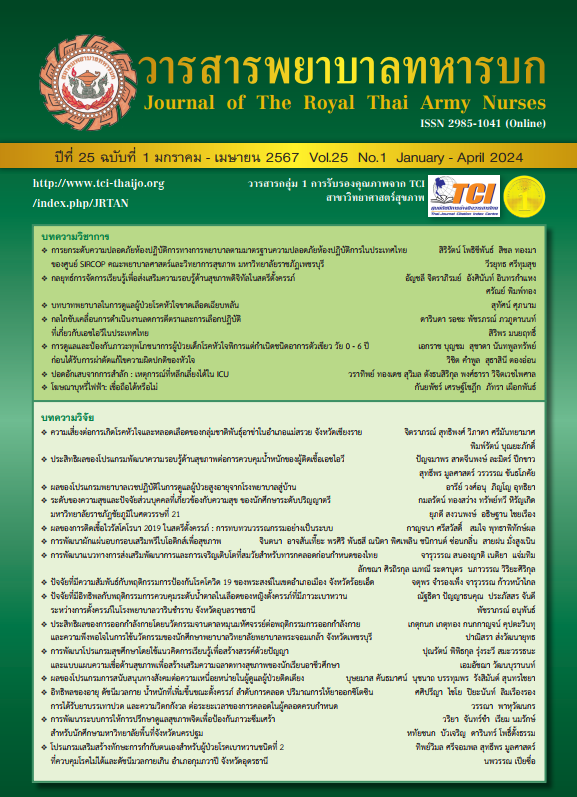The Development of Nursing Model for Promoting Optimal Birth Outcomes in Pregnant Women with Secondhand Smoke Exposure
Keywords:
Nursing Model, Optimal Birth Outcomes, Pregnant Women with Secondhand Smoke ExposureAbstract
This action research aimed to develop a nursing model for promoting optimal birth outcomes in pregnant women with secondhand smoke exposure. The subjects were forty club advisors at central division network of nursing institutions in Bangkok. They were recruited by the purposive sampling and quota sampling. Data collection used the questionnaires of health promotion knowledge. The nursing knowledge in promoting optimal birth outcomes in pregnant women with secondhand smoke exposure test was verified by the five experts (IOC) .06 - 1.00. The reliability of the research instrument (KR-20) was. 794. Data analysis used the descriptive statistics and pair t-test.
The results showed that after intervention, the subjects were approximately 72.5% having the highest level of prenatal health promotion knowledge score. Additionally, the mean score of prenatal health promotion knowledge in post- intervention was significantly higher than pre-intervention at .05 (t =17.323, df = 39, p <.001). As the result revealed that prenatal health promotion nursing model; 1) perceiving the benefits and barriers of health behaviors, 2) encouraging family participation in health care, 3) practicing health behaviors, 4) preparing health educational application, 5) providing individual counseling online, and 6) monitoring continuous health status. The recommendation of this study should be developed the application system for helping pregnant women to avoid secondhand smoke exposure and developed the effective referral system for preventing adverse birth outcomes.
Downloads
References
Ajori L, Ghanbari M, Ghanbari A, Esgandari M, Adib M, Dehghani Z. Comparison of pregnancy outcome in pregnant women (third trimester) with and without anemia: Case-control study from Iran. International Archives of Health Sciences. 2024.
Duryea EL, Schell RC. Anemia. Queenan’s management of high-risk pregnancy: an evidence-based approach. 2024.
Glick I, Kadish E, Rottenstreich M. Management of pregnancy in women of advanced maternal age: improving outcomes for mother and baby. International journal of women’s health. 2021.
Pandey AK, Gautam D, Tolani H, Neogi SB. Clinical outcome post treatment of anemia in pregnancy with intravenous versus oral iron therapy: a systematic review and meta-analysis. Scientific Reports. 2024.
Liu B, Lu X, Jiang A, Lv Y, Zhang H, Xu B. Influence of maternal endocrine disrupting chemicals exposure on adverse pregnancy outcomes: A systematic review and meta-analysis. Ecotoxicology and Environmental Safety. 2024.
Tungtrongvisolkit N. & Seaharattanapatum B. Experiences of smoking cessation focused on barriers and facilitators by husbands with smoking tobaccos during wives getting pregnant with anemia in urban community: A Qualitative Research. Open Access Library Journal, 2021.8(5).1-13.
Pender NJ, Murdaugh CL, Parsons MA. Health promotion in nursing practice. 5th ed. Jurong, Singapore: Pearson; 2006.
Turner AR, Reed SM. Theory Analysis: The health promotion model and motivation in physical activity. Research and Theory for Nursing Practice. 2023.
Wilson JC. Nola J. Pender: Health promotion model. Nursing Theorists and Their Work E-Book. 2021.
Songsermpong S, Rodphothong J, Piriyaudomporn P. Development of a care model for high-risk pregnant women in the digital transformation Era. Journal of Health Science. 2023 Aug 30;32 (Supplement 1): S125-137.
Gamde MS, Obeagu EI. Iron Deficiency Anaemia: enemical to pregnancy. European Journal of Biomedical. 2023;10(9):272-275.
Kayumova GM, Nutfilloyevich KK. Cause of perinatal loss with premature rupture of amniotic fluid in women with anemia. AMALIY VA TIBBIYOT FANLARI ILMIY JURNALI. 2023.;2(11):131-36.
Suryanih S, Galaupa R. Increasing knowledge in pregnant women about anemia screening and triple elimination through pregnant women classes. International Journal of Medicine and Health. 2023.2(1):17-25.
Biete A, Gonçalves VS, Franceschini SC, Nilson EA, Pizato N. The prevalence of nutritional anaemia in Brazilian pregnant women: a systematic review and meta-analysis. International Journal of Environmental Research and Public Health. 2023.20(2): 15-9.
Tanaka K, Nishigori H, Watanabe Z, Tanoue K, Iwama N, Satoh M, Murakami T, Hoshiai T, Saito M, Mizuno S, Sakurai K. Secondhand smoke exposure is associated with the risk of hypertensive disorders of pregnancy: the Japan Environment and Children’s Study. Hypertension Research. 2023.46(4):834-44.
Nanninga EK, Weiland S, Berger MY, Feijen-de Jong EI, Erwich JJ, Peters LL. Adverse maternal and infant outcomes of women who differ in smoking status: E-cigarette and tobacco cigarette users. International Journal of Environmental Research and Public Health. 2023.;20(3): 26-32.
Guri-Scherman AL, Neumark Y, Rodnay M, Bar-Zeev Y. Barriers and enablers to implementing a smoke-free home and car during pregnancy: a Qualitative Study among expectant Israeli fathers. Nicotine and Tobacco Research. 2024.;26(1):94-101.
Cavichiolli FS, Borovac-Pinheiro A, Lajos GJ, Becker M, Passini Jr R, Brazilian Multicenter Study on Preterm Birth Study Group, Marba ST, Matias JP, Maia Filho NL, Borges VT, Oliveira LR. The relationship between active/passive smoking and spontaneous preterm birth: Data from a multicenter study. International Journal of Gynecology & Obstetrics. 2024.
Wang YT, Hu KR, Jian ZH, Ai FL, Shi YL, Wang XW, Yang WY, Wang JX, Ai LM, Xia WA. The Association between Exposure to SecondHand Smoke and Disease in the Chinese Population: A Systematic Review and Meta-Analysis. Biomedical and Environmental Sciences. 2023.;36(1): 24-37.
Cohn AM, Elmasry H, Wild RC, Johnson AL, Abudayyeh H, Kurti A, Coleman-Cowger VH. Birth outcomes associated with e-cigarette and non–e-cigarette tobacco product use during pregnancy: An examination of PATH data waves 1–5. Nicotine and Tobacco Research. 2023.;25(3): 444-52.
Harun H, Daud A, Amiruddin R, Sabir M, Hadju V, Mallongi A, Talebe T, Faris M. The Effect of pre-conception Moringa Leaf Extract Supplementation on Cotinine Serum Levels in Pregnant Women Exposed to Tobacco Smoke. Pharmacognosy Journal. 2023;15(2).
Lin SY, Wang L, Zhou W, Kitsantas P, Wen X, Xue H. E-cigarette use during pregnancy and its association with adverse birth outcomes in the US. Preventive Medicine. 2023.;166: 107375.
Bendotti H, Lawler S, Gartner C, Ireland D, Marshall HM. Smoking cessation counseling in practice: a qualitative analysis of Quitline conversations in Queensland, Australia. Health Education & Behavior. 2024.;51(1):43-53.
Strayer SM, Barnhardt A, Rollins LK, Ingersoll K, Yan G, Elward KS, Schorling JB. Assessing efficacy of a web-based smoking cessation tool-Quit Advisor MD: Protocol for a practice-based, clustered, randomized control trial. Contemporary Clinical Trials Communications. 2024.28: 101253.
Pierrot B, Legendre G, Riou J, Gentil A, Molle-Guiliani B, Petit A. Pregnancy and tobacco: practice and knowledge of French midwives. Midwifery. 2024.;129: 103886.
Downloads
Published
How to Cite
Issue
Section
License
Copyright (c) 2024 Journal of The Royal Thai Army Nurses

This work is licensed under a Creative Commons Attribution-NonCommercial-NoDerivatives 4.0 International License.
บทความหรือข้อคิดเห็นใดใดที่ปรากฏในวารสารพยาบาลทหารบกเป็นวรรณกรรมของผู้เขียน ซึ่งบรรณาธิการหรือสมาคมพยาบาลทหารบก ไม่จำเป็นต้องเห็นด้วย
บทความที่ได้รับการตีพิมพ์เป็นลิขสิทธิ์ของวารสารพยาบาลทหารบก
The ideas and opinions expressed in the Journal of The Royal Thai Army Nurses are those of the authors and not necessarily those
of the editor or Royal Thai Army Nurses Association.





